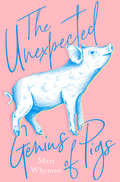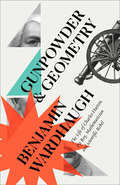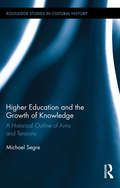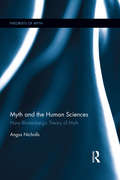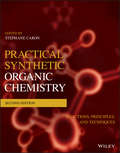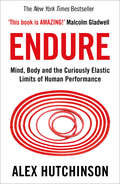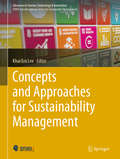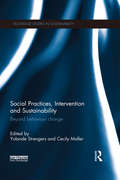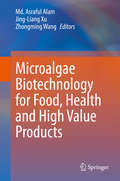- Table View
- List View
Reviews of Environmental Contamination and Toxicology 164 (Reviews of Environmental Contamination and Toxicology #187)
by George W. WareReviews of Environmental Contamination and Toxicology provides detailed review articles concerned with aspects of chemical contaminants, including pesticides, in the total environment with toxicological considerations and consequences.
The Unexpected Genius of Pigs
by Matt WhymanWe often consider dogs to be our enduring sidekicks but the truth is domestic pigs have played a role in our lives for nearly as long. Pigs are highly social and smart. They like to play. They’re inventive, crafty and belligerent – and incredibly singleminded. Ultimately, we have far more in common with these creatures than we like to admit.
Gunpowder and Geometry: The Life Of Charles Hutton, Pit Boy, Mathematician And Scientific Rebel
by Benjamin WardhaughAugust, 1755. Newcastle, on the north bank of the Tyne.
Environmentalism, Ethical Trade, and Commodification: Technologies of Value and the Forest Stewardship Council in Chile (Routledge Studies in Anthropology)
by Adam HenneThis book explores the global connections between Chilean landscapes and Northern consumers embodied by the Forest Stewardship Council logo, the green seal of approval for certified sustainably-produced "good wood." How do we decide what makes good forestry? What knowledges and values are expressed or silenced when "good" is defined with a market mechanism like certification? Henne's ethnographic study documents the new forms of labor and the new expectations about sustainability and responsibility that certification generates, in the context of the competing ideas about how to manage a forest – or even what a forest is – that constitute forest certification in Chile. A critical analysis of certification’s practices helps understand the role of ethical trade initiatives in creating sustainable, survivable global futures.
Higher Education and the Growth of Knowledge: A Historical Outline of Aims and Tensions (Routledge Studies in Cultural History)
by Michael SegreThis book sketches the history of higher education, in parallel with the development of science. Its goal is to draw attention to the historical tensions between the aims of higher education and those of science, in the hope of contributing to improving the contemporary university. A helpful tool in analyzing these intellectual and social tensions is Karl Popper's philosophy of science demarcating science and its social context. Popper defines a society that encourages criticism as "open," and argues convincingly that an open society is the most appropriate one for the growth of science. A "closed society," on the other hand, is a tribal and dogmatic society. Despite being the universal home of science today, the university, as an institution that is thousands of years old, carries traces of different past cultural, social, and educational traditions. The book argues that, by and large, the university was, and still is, a closed society and does not serve the best interests of the development of science and of students' education.
Bioremediation and Biotechnology: Sustainable Approaches to Pollution Degradation
by Khalid Rehman Hakeem Rouf Ahmad Bhat Humaira QadriToxic substances threatens aquatic and terrestrial ecosystems and ultimately human health. The book is a thoughtful effort in bringing forth the role of biotechnology for bioremediation and restoration of the ecosystems degraded by toxic and heavy metal pollution. The introductory chapters of the book deal with the understanding of the issues concerned with the pollution caused by toxic elements and heavy metals and their impacts on the different ecosystems followed by the techniques involved in monitoring of the pollution. These techniques include use of bio-indicators as well as modern techniques for the assessment and monitoring of toxicants in the environment. Detailed chapters discussing the role of microbial biota, aquatic plants, terrestrial plants to enhance the accumulation efficiency of these toxic and heavy metals are followed by remediation techniques involving myco-remediation, bio-pesticides, bio-fertilizers, phyto-remediation and rhizo-filtration. A sizable portion of the book has been dedicated to the advanced bio-remediation techniques which are finding their way from the laboratory to the field for revival of the degraded ecosystems. These involve bio-films, micro-algae, genetically modified plants and filter feeders. Furthermore, the book is a detailed comprehensive account for the treatment technologies from unsustainable to sustainable. We believe academicians, researchers and students will find this book informative as a complete reference for biotechnological intervention for sustainable treatment of pollution.
Formation and Control of Biofilm in Various Environments
by Hideyuki Kanematsu Dana M. BarryThis book provides excellent techniques for detecting and evaluating biofilms: sticky films on materials that are formed by bacterial activity and produce a range of industrial and medical problems such as corrosion, sanitary problems, and infections. Accordingly, it is essential to control biofilms and to establish appropriate countermeasures, from both industrial and medical viewpoints. This book offers valuable, detailed information on these countermeasures. It also discusses the fundamentals of biofilms, relates various substrates to biofilms, and presents a variety of biofilm reactors. However, the most important feature of this book (unlike others on the market) is its clear focus on addressing the practical aspects from an engineering viewpoint. Therefore, it offers an excellent practical guide for engineers and researchers in various fields, and can also be used as a great academic textbook.
Electrically Driven Quantum Dot Based Single-Photon Sources: Modeling and Simulation (Springer Theses)
by Markus KantnerSemiconductor quantum optics is on the verge of moving from the lab to real world applications. When stepping from basic research to new technologies, device engineers will need new simulation tools for the design and optimization of quantum light sources, which combine classical device physics with cavity quantum electrodynamics. This thesis aims to provide a holistic description of single-photon emitting diodes by bridging the gap between microscopic and macroscopic modeling approaches. The central result is a novel hybrid quantum-classical model system that self-consistently couples semi-classical carrier transport theory with open quantum many-body systems. This allows for a comprehensive description of quantum light emitting diodes on multiple scales: It enables the calculation of the quantum optical figures of merit together with the simulation of the spatially resolved current flow in complex, multi-dimensional semiconductor device geometries out of one box. The hybrid system is shown to be consistent with fundamental laws of (non-)equilibrium thermodynamics and is demonstrated by numerical simulations of realistic devices.
Symphony in C (Almost) Everything: Carbon And The Evolution Of (almost) Everything
by Robert HazenAn enchanting biography of the most resonant – and most necessary – chemical element on Earth.
Myth and the Human Sciences: Hans Blumenberg's Theory of Myth (Theorists of Myth)
by Angus NichollsThis is the first book-length critical analysis in any language of Hans Blumenberg’s theory of myth. Blumenberg can be regarded as the most important German theorist of myth of the second half of the twentieth century, and his Work on Myth (1979) has resonated across disciplines ranging from literary theory, via philosophy, religious studies and anthropology, to the history and philosophy of science. Nicholls introduces Anglophone readers to Blumenberg’s biography and to his philosophical contexts. He elucidates Blumenberg’s theory of myth by relating it to three important developments in late nineteenth- and early twentieth-century German philosophy (hermeneutics, phenomenology and philosophical anthropology), while also comparing Blumenberg’s ideas with those of other prominent theorists of myth such as Vico, Hume, Schelling, Max Müller, Frazer, Sorel, Freud, Cassirer, Heidegger, Horkheimer and Adorno. According to Nicholls, Blumenberg’s theory of myth can only be understood in relation to the ‘human sciences,’ since it emerges from a speculative hypothesis concerning the emergence of the earliest human beings. For Blumenberg, myth was originally a cultural adaptation that constituted the human attempt to deal with anxieties concerning the threatening forces of nature by anthropomorphizing those forces into mythic images. In the final two chapters, Blumenberg’s theory of myth is placed within the post-war political context of West Germany. Through a consideration of Blumenberg’s exchanges with Carl Schmitt, as well as by analysing unpublished correspondence and parts of the original Work of Myth manuscript that Blumenberg held back from publication, Nicholls shows that Blumenberg’s theory of myth also amounted to a reckoning with the legacy of National Socialism.
Myth and the Human Sciences: Hans Blumenberg's Theory of Myth (Theorists of Myth)
by Angus NichollsThis is the first book-length critical analysis in any language of Hans Blumenberg’s theory of myth. Blumenberg can be regarded as the most important German theorist of myth of the second half of the twentieth century, and his Work on Myth (1979) has resonated across disciplines ranging from literary theory, via philosophy, religious studies and anthropology, to the history and philosophy of science. Nicholls introduces Anglophone readers to Blumenberg’s biography and to his philosophical contexts. He elucidates Blumenberg’s theory of myth by relating it to three important developments in late nineteenth- and early twentieth-century German philosophy (hermeneutics, phenomenology and philosophical anthropology), while also comparing Blumenberg’s ideas with those of other prominent theorists of myth such as Vico, Hume, Schelling, Max Müller, Frazer, Sorel, Freud, Cassirer, Heidegger, Horkheimer and Adorno. According to Nicholls, Blumenberg’s theory of myth can only be understood in relation to the ‘human sciences,’ since it emerges from a speculative hypothesis concerning the emergence of the earliest human beings. For Blumenberg, myth was originally a cultural adaptation that constituted the human attempt to deal with anxieties concerning the threatening forces of nature by anthropomorphizing those forces into mythic images. In the final two chapters, Blumenberg’s theory of myth is placed within the post-war political context of West Germany. Through a consideration of Blumenberg’s exchanges with Carl Schmitt, as well as by analysing unpublished correspondence and parts of the original Work of Myth manuscript that Blumenberg held back from publication, Nicholls shows that Blumenberg’s theory of myth also amounted to a reckoning with the legacy of National Socialism.
Routledge Handbook of Forest Ecology (Routledge Environment and Sustainability Handbooks)
by Richard T. Corlett Yves Bergeron Kelvin S. H PehThis comprehensive handbook provides a unique resource covering all aspects of forest ecology from a global perspective. It covers both natural and managed forests, from boreal, temperate, sub-tropical and tropical regions of the world. The book is divided into seven parts, addressing the following themes: forest types forest dynamics forest flora and fauna energy and nutrients forest conservation and management forests and climate change human impacts on forest ecology. While each chapter can stand alone as a suitable resource for a lecture or seminar, the complete book provides an essential reference text for a wide range of students of ecology, environmental science, forestry, geography and natural resource management. Contributors include leading authorities from all parts of the world.
Strategic Corporate Conservation Planning: A Guide to Meaningful Engagement
by Margaret O'GormanIndustries that drive economic growth and support our comfortable modern lifestyles have exploited natural resources to do so. But now there’s growing understanding that business can benefit from a better relationship with the environment.Leading corporations have begun to leverage nature‑based remediation, restoration, and enhanced lands management to meet a variety of business needs, such as increasing employee engagement and establishing key performance indicators for reporting and disclosures. Strategic Corporate Conservation Planning offers fresh insights for corporations and environmental groups looking to create mutually beneficial partnerships that use conservation action to address business challenges and realize meaningful environmental outcomes. Myriad case studies featuring programs from habitat restoration to environmental educational initiatives at companies like Bridgestone USA, General Motors, and CRH Americas are included to help spark new ideas.
Practical Synthetic Organic Chemistry: Reactions, Principles, and Techniques
by Stéphane CaronThis book is a hands-on guide for the organic chemist. Focusing on the most reliable and useful reactions, the chapter authors provide the information necessary for a chemist to strategically plan a synthesis, as well as repeat the procedures in the laboratory. Consolidates all the key advances/concepts in one book, covering the most important reactions in organic chemistry, including substitutions, additions, eliminations, rearrangements, oxidations, reductions Highlights the most important reactions, addressing basic principles, advantages/disadvantages of the methodology, mechanism, and techniques for achieving laboratory success Features new content on recent advances in CH activation, photoredox and electrochemistry, continuous chemistry, and application of biocatalysis in synthesis Revamps chapters to include new and additional examples of chemistry that have been demonstrated at a practical scale
It All Adds Up: Humans And Mathematics From Prehistory To Modern Day
by Mickael Launay‘Fascinating … so enlightening that suddenly maths doesn’t seem so fearsome as it once did’ SIMON WINCHESTER From Aristotle to Ada Lovelace: a brief history of the mathematical ideas that have forever changed the world and the everyday people and pioneers behind them. The story of our best invention yet.
Pathogenicity and Drug Resistance of Human Pathogens: Mechanisms and Novel Approaches
by Saif Hameed Zeeshan FatimaThe book comprehensively discusses the mechanisms of pathogenesis and drug resistance; current diagnostics landscape of four key human pathogens; bacterial, fungal, protozoans and viral which are the causes of major infectious diseases. It also assesses the emerging technologies for the detection and quantification of these pathogens. Further, it discusses the novel opportunities to fight against these infectious diseases and to identify pertinent drug targets with novel methodologies. It also reviews the current and future insights into the control, elimination, and eradication of these infectious diseases. Importantly, the book discusses the epidemiological characteristics and various challenges in combating Ebola and Influenza diseases. Finally, the book highlights the growing role of nanotechnology and bioinformatics resources for combating the infectious diseases. In summary, the book provides the mechanistic insight of the pathogenicity, drug-resistance, therapeutic strategies and identification of the novel drug targets of Mycobacterium tuberculosis, Plasmodium, Candida, Hepatitis C and emerging viral infections.
Experimentelle Pflanzenökologie: Grundlagen und Anwendungen (Springer Reference Naturwissenschaften)
by Rainer Matyssek Werner B. HerppichAllen, die mit Planung, Durchführung und Auswertung von pflanzenökologischen Experimenten zu tun haben, bietet dieses Handbuch eine zuverlässige Basis. Die Autoren beschreiben die biophysikalischen, physikalisch-chemischen und physiologischen Grundlagen der experimentellen Pflanzenökologie sowie die Interaktionen zwischen Pflanzen und abiotischen Faktoren. Schwerpunktmäßig konzentrieren sie sich dabei auf Teilbereiche, die für den Freilandeinsatz von hoher Bedeutung sind. So behandeln sie insbesondere Fragen des Kohlenstoff- und des Wasserhaushaltes. Dabei werden einzelne Aspekte gezielt tiefgehend behandelt, auf ein oberflächliches Ansprechen möglichst vieler Teilbereiche dagegen verzichtet. Mineralstoffhaushalt und Bodenökologie wurden als Themen bewusst ausgeklammert, da für diese zum Teil andere wissenschaftliche und methodische Anforderungen gelten. Die Darstellung und Erläuterung von Messtechniken und Arbeitsmethoden der modernen experimentellen Pflanzenökologie runden das Buch ab.
Endure: Mind, Body, And The Curiously Elastic Limits Of Human Performance
by Alex Hutchinson‘This book is AMAZING!’ – MALCOLM GLADWELL ‘If you want to gain insight into the mind of great athletes, adventurers, and peak performers then prepare to be enthralled by Alex Hutchinson’s Endure.’ – BEAR GRYLLS
Accounts on Sustainable Flow Chemistry (Topics in Current Chemistry Collections)
The series Topics in Current Chemistry Collections presents critical reviews from the journal Topics in Current Chemistry organized in topical volumes. The scope of coverage is all areas of chemical science including the interfaces with related disciplines such as biology, medicine and materials science. The goal of each thematic volume is to give the non-specialist reader, whether in academia or industry, a comprehensive insight into an area where new research is emerging which is of interest to a larger scientific audience.Each review within the volume critically surveys one aspect of that topic and places it within the context of the volume as a whole. The most significant developments of the last 5 to 10 years are presented using selected examples to illustrate the principles discussed. The coverage is not intended to be an exhaustive summary of the field or include large quantities of data, but should rather be conceptual, concentrating on the methodological thinking that will allow the non-specialist reader to understand the information presented. Contributions also offer an outlook on potential future developments in the field.
Progress in Botany Vol. 81 (Progress in Botany #81)
by Francisco M. Cánovas Ulrich Lüttge Christoph Leuschner María-Carmen RisueñoWith one volume each year, this series keeps scientists and advanced students informed of the latest developments and results in all areas of the plant sciences. The present volume includes reviews on plant physiology, biochemistry, genetics and genomics, forests, and ecosystems.
The Unedited: A Novel About Genome and Identity (Science and Fiction)
by Pernille RørthThis novel is set in the near future, where human genome editing has become routine. First adopted to fight a lethal virus, it is now widely used to prevent diseases and favor other traits. Ben, Eiko, Celia, Raphael and Leo have just had their coming-of-age genome reading and are struggling with this new information for each their own reasons. Soon, they are cast into the middle of a crisis that threatens the future of their society and pits it against a parallel, but strictly separated, society where genome manipulation is forbidden on religious grounds. The book includes an essay on the potential of human genome engineering and related genome-based choices.
Concepts and Approaches for Sustainability Management (Advances in Science, Technology & Innovation)
by Khai Ern LeeWith the introduction of the 2030 Agenda for Sustainable Development by the United Nations General Assembly in 25 September 2015, UN agencies, member states and stakeholders have begun to focus on the adoption and implementation of these strategies in realization of 17 Sustainable Development Goals. To work toward sustainability, strategic measures to encourage stakeholders to contribute to the goals of the 2030 agenda are needed. In recognition of these efforts, this book is produced to compile research concepts and approaches for the area of sustainability management of industry, technology development, community, education and the environment. The objective of this book is to deliberate concepts and approaches of sustainability management taking place in Malaysia whereby case studies will be revealed to provide way forward of sustainability management toward achieving sustainable development. The insights provided can be applied to advanced and developing countries by sustainable development practitioners, encompassing government agencies, academia, industries, NGOs and community, who would like to adopt the concept of approach of sustainability into their area of management.
Social Practices, Intervention and Sustainability: Beyond behaviour change (Routledge Studies in Sustainability)
by Yolande Strengers Cecily MallerIn an era of dramatic environmental change, social change is desperately needed to curb burgeoning consumption. Many calls to action have focused on individual behaviour or technological innovation, with relative silence from the social sciences on other modes and methods of intervening in social life. This book shows how we can go beyond behaviour change in the pursuit of sustainability. Inspired by the ‘practice turn’ in consumption studies, this interdisciplinary book looks through the lens of social practice theory to explore important and timely questions about how to intervene in social life. It discusses a range of applied sustainability topics including energy consumption, housing provision, water demand, transport, climate change, curbside recycling and smart grids, seeking to redefine what intervention is, how it happens, and who or what can intervene to address the growing list of environmental calamities facing contemporary societies. These issues are explored through a range of specific case studies from Australia, the UK and the US, providing theoretical insights that are of international relevance. The book will be of interest to researchers and students in the fields of sociology, consumption studies, environmental studies, geography, and science and technology studies, as well as policy makers and practitioners seeking to intervene in social life for sustainability.
Social Practices, Intervention and Sustainability: Beyond behaviour change (Routledge Studies in Sustainability)
by Yolande Strengers Cecily MallerIn an era of dramatic environmental change, social change is desperately needed to curb burgeoning consumption. Many calls to action have focused on individual behaviour or technological innovation, with relative silence from the social sciences on other modes and methods of intervening in social life. This book shows how we can go beyond behaviour change in the pursuit of sustainability. Inspired by the ‘practice turn’ in consumption studies, this interdisciplinary book looks through the lens of social practice theory to explore important and timely questions about how to intervene in social life. It discusses a range of applied sustainability topics including energy consumption, housing provision, water demand, transport, climate change, curbside recycling and smart grids, seeking to redefine what intervention is, how it happens, and who or what can intervene to address the growing list of environmental calamities facing contemporary societies. These issues are explored through a range of specific case studies from Australia, the UK and the US, providing theoretical insights that are of international relevance. The book will be of interest to researchers and students in the fields of sociology, consumption studies, environmental studies, geography, and science and technology studies, as well as policy makers and practitioners seeking to intervene in social life for sustainability.
Microalgae Biotechnology for Food, Health and High Value Products
by Md. Asraful Alam Jing-Liang Xu Zhongming Wang"Microalgae Biotechnology for Food, Health and High Value Products” presents the latest technological innovations in microalgae production, market status of algal biomass-based products, and future prospects for microalgal applications. It provides stimulating overviews from different perspectives of application that demonstrate how rapidly the commercial production of microalgae-based food, health and high value products is advancing. It also addresses a range of open questions and challenges in this field. The book highlights the latest advances of interest to those already working in the field, while providing a comprehensive overview for those readers just beginning to learn about the promise of microalgae as a sustainable source of both specialty and commercial products. It offers a valuable asset for commercial algae producers, algae product developers, scientific researchers and students who are dedicated to the advancement of microalgae biotechnology for applications in health, diet, nutrition, cosmetics, biomaterials etc.

